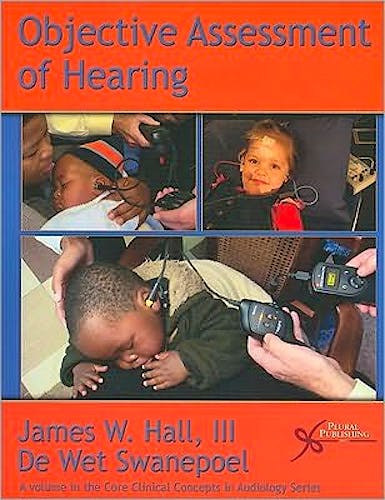

No hay productos en el carrito



Objective Assessment of Hearing
Hall, J.W. — Swanepoel, de W.
1ª Edición Diciembre 2009
Inglés
Tapa blanda
200 pags
1000 gr
22 x 28 x 1 cm
ISBN 9781597563536
Editorial Plural Publishing Inc
LIBRO IMPRESO
-5%
44,75 €42,51 €IVA incluido
43,03 €40,88 €IVA no incluido
Recíbelo en un plazo de
2 - 3 semanas
This book bridges the gap between theory and clinical application for electro-acoustic and electro-physiologic assessment of hearing loss across the age range. Strategies and techniques for screening and diagnosis of hearing loss are presented clearly and simply. The authors incorporate findings of accumulated clinical experience and recent clinical research in a readable review of electro-acoustic measures (immittance measures and otoacoustic emissions) and electro-physiologic measures (electrocochleography, ABR and ASSR) that are essential for best practice in audiology today. This book is a one-stop resource for clinicians who are responsible for the diagnostic auditory assessment of children and adults.
Table of contents
Chapter 1: Rationale for Objective Hearing Assessment
- Differentiate screening versus diagnostic measures
- Differentiate auditory dysfunction vs. hearing sensitivity vs. hearing
- Cross-check principle revisited … test battery approach (classic quote)
- What we need to get from a hearing assessment
Degree of hearing loss
Configuration
Symmetry
Frequency specific thresholds
Ear specific thresholds
Valid and reliable measures - Clinical limitations of behavioral audiometry
Age
Neurological immaturity
Sensitivity and specificity - Identification (screening) of hearing loss (auditory dysfunction)
Distinguish between auditory vs. hearing sensitivity vs. hearing (cortical function)
Purpose of hearing loss identification
Principles of screening
Principles of sensitivity and specificity
Options for screening - Factors influencing hearing loss identification
Age
State of arousal
TABLE for all techniques - Estimation of hearing thresholds
Purpose of hearing threshold estimation with electro acoustic techniques - Factors influencing hearing threshold estimation
Age
State of arousal
TABLE for all techniques
Chapter 2: Immittance Measurements
- Introduction and historical perspective
- Anatomy and physiology in a nutshell (Figures)
- Identification of hearing loss (screening)
Tympanometry
Single vs. multi-component
Low vs. high frequency probe tone
Jerger classification
ASHA guidelines
Gradient - Wide Band Reflectance
- Acoustic reflex thresholds for broad-band noise signals
- Estimation of hearing loss
- Sensitivity Prediction by Acoustic Reflex (SPAR)
- Other acoustic reflex predictive techniques
Acoustic reflex thresholds for broad-band noise signals - Clinical considerations and constraints (TABLE)
Subject factors (list as many as possible) - Pathologic factors (list as many as possible)
Summary of clinical application
Chapter 3: Otoacoustic Emissions (OAEs)
- Screening for hearing loss
Transient OAEs (TEOAEs)
Distortion product OAEs (DPOAEs)
Automated techniques - Estimation of hearing loss
Relation of OAEs to the audiogram
Statistical attempts to estimate hearing loss with OAEs - Clinical considerations and constraints
Subject factors
Pathologic factors
Auditory neuropathy
Summary of clinical application
Chapter 4: Electrocochleography (ECochG)
- Identification of hearing loss
- Estimation of hearing thresholds
Electrode options
Dynamic range for intensity
Frequency specificity
Clinical considerations and constraints
Subject factors
Pathologic factors
Sedation and anesthesia
Auditory neuropathy
Summary of clinical application
Chapter 5: Auditory Brainstem Response (ABR)
- Screening for identification of hearing loss
Automated ABR
Detection algorithms and techniques - Estimation of hearing thresholds
Stimulus options
Tone-burst ABRs
Latency-intensity functions
Bone conduction ABRs - Clinical considerations and constraints
Subject factors
Pathologic factors
Sedation and anesthesia
Alternative non-sedation strategies
Auditory neuropathy
Summary of clinical application
Chapter 6: Auditory Steady State Response (ASSR)
- Background to the ASSR
- Defining the ASSR
Response physiology
Neural generators
Stimulus characteristics
Type of stimuli
Presentation of stimuli
Clinical stimulus protocols
Response measurement
Improving the signal-to-noise ratio
Clinical recording protocols
Response analysis
Spectral analysis
Phase analysis
Considerations in analysis - Estimating hearing thresholds
General subject factors
Hearing loss characteristics
Bone conduction
Sound-field measurements
Sedation & anesthesia
Remaining clinical questions - Summary of clinical application
Chapter 7: Recommendations for Objective Identification and Estimation of Hearing Loss
- Guidelines, recommendations, and standard of care
- New directions for research
- Combined OAE/ABR hearing screening technique
Infants
Pre-school and school-age children
Adults - Test battery approach for estimation of hearing loss
Children
Adults - Once again … what we need to get from a hearing assessment
- Advantages of electro-acoustic and electro-physiologic measures
Chapter 8: Illustrative Case Reports and Clinical Findings
- Normal hearing
- Conductive hearing loss
- Sensory hearing loss
- Auditory neuropathy
- Complex case
HIV
REFERENCES
APPENDICES
A. Clinical forms
B. Normative data
© 2025 Axón Librería S.L.
2.149.0